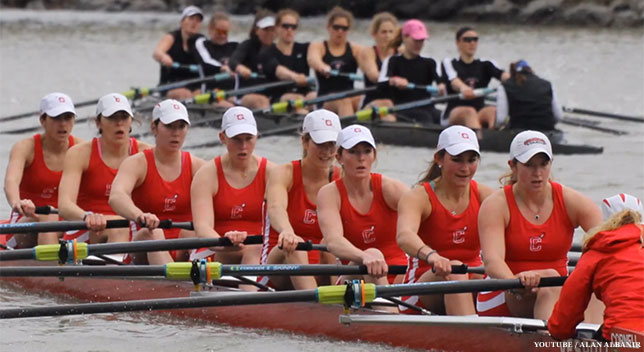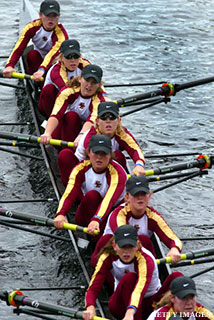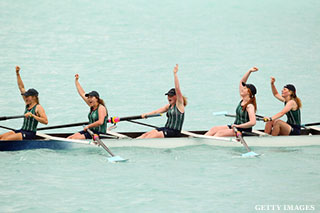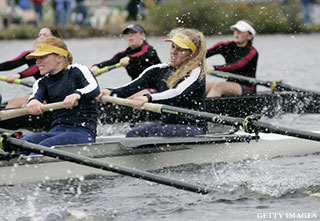Oars beat a steady rhythm against the water. Eight young women pour all of their energy into this repetitive motion while one sits at the stern, coaching them through it, as the much of the world around them is still sound asleep. There is a camaraderie to the rhythm they beat at the early hour, and a shared, unspoken goal to be the best. More and more, this is the scene being played out across the country, as girls row and see the sun rise over the Washington Monument or the Space Needle or the Bay Bridge.
"The difference between rowing and sports like basketball or soccer is that in those sports, there can blatantly be one star on the team," says Hannah Wilson, 21, senior co-captain of the Cornell women's rowing team. "All the players have such different roles. In a boat, we're going for synchronization, so there shouldn’t be someone that stands out. It's really cool to see a sport where everyone is working so hard individually to come together, to just be completely part of a team that can't function without everyone else. It teaches you a lot."

Wilson is one of more than 5,600 female college students now rowing at a Division I school, a greater number than women playing both basketball and softball. The sport has seen a 63 percent increase in women participating at the Division I level since 1997,when it officially became an NCAA sport. High school and college coaches alike have noted the increase popularity particularly in the past five years, and new rowing clubs have sprung up in cities with access to an appropriate body of water.
The lure of scholarship opportunities has accounted for a big part of this surge. The NCAA caps the number of scholarships that can be offered for a particular sport. With 20 scholarships available per school for women's rowing, rowing has more than any other sport -- men's or women's -- aside from football. If every team in the NCAA offered its maximum number of allotted scholarships, nearly 2,900 rowing scholarships would be available to high school girls.
"If you break down the demographics, junior girls is probably the biggest sector where there's been such growth,” says Megan Kennedy, coach and founder of the crew team at Mount Saint Joseph Academy, an all-girls Catholic school outside Philadelphia. "Junior programs are growing all over the place. Schools that never had programs before now do. Even in an area like Philadelphia, where rowing has been since the Civil War, there’s still so many new opportunities and new programs every year."

The increase in interest at the high school level is most likely attributed to the sport's growth in the NCAA.
"Women's rowing became an NCAA sport in 1997, which essentially created rowing programs at many universities that, prior to 1997, either weren’t varsity status or didn’t have a program at all," says Cornell coach Hilary Gehman. "Once it became an NCAA sport, they added rowing and put a lot of money into it and that created so much opportunity."
Gehman says that more people become aware of rowing as students learn about classmates who are involved in the sport and their parents encourage them to try something new. The effect it has on the recruitment pool has benefits and drawbacks.
"There's a lot more rowing at the high school level now," Gehman says. "It's definitely increased the level of recruiting, but it also has diluted it as well. Rowers know that there are opportunities for scholarships and recruitment, but there's a level of athlete that’s not recruitable who may think she is. I think we're getting a lot more high quality rowers from the opportunities in high school that have grown over the past five years. But there are also quite a few more rowers who believe that because they row, they can be recruited, which can be challenging for the college coaches."
With the enticement of scholarships, some girls scramble to pick up rowing in the latter stages of high school, which isn't the most realistic approach.
"Last year we had three girls who were seniors and joined the team as novices and were flat-out hoping they would get recruited on their one year of experience,” says Briana Schulte, operations manager and varsity girls' coach at Pocock Rowing Center in Seattle. Schulte previously coached at Purdue and University of Pennsylvania.

A lot of girls and their families hope that with recruitment comes a scholarship. But Ivy League schools don’t offer athletic scholarships in any sport, and participating in rowing doesn’t guarantee financial support from or admission to any college.
"Rowing shouldn’t be considered a strategy for college recruiting," says Ryan Sparks, founder of Sparks Consulting, a group specifically geared toward placing skilled high school rowers at a college. “There are plenty of folks and recruiting businesses that look at it that way. Sports are about development of life skills, not accomplishment of an admission or scholarship."
Rowing experts say it isn’t practical to continue the sport without a passion for it.
"By the time they've done it for three years, they’re so committed to rowing,” Kennedy says. “College admission might have been the initial reason that they tried out or came to a learn-to-row session, but that’s not the reason that they stay. It’s just too much time."
Wilson says that, in the long term, this has a positive impact on the sport.
"The nice thing with rowing is that you weed out people who are just there to goof around,” Wilson says. “Because it’s such a hard sport that you wouldn’t be there if you didn’t love rowing."
In fact, it may not be the students who are insisting on using rowing as a form of resumé-padding or a strategy for scholarships.
"Parents are looking at it as an angle to get a leg up in college admissions,” Schulte says.
Over-involved parents, Gehman says, may actually weaken their child’s chances of getting recruited.
"The parents who play a huge role are probably the ones who pushed their kids into looking at rowing as a recruitment opportunity,” Gehman adds. “We’ve recruited people in the past who the majority of my correspondence has been with parents or the guidance counselors, not with the athlete herself. That's a red flag to me."

Those in the sport have seen parents pay for things other than regular training in an effort to gain scholarships for their daughters.
"It's a lot more common for kids to be going to camps that focus on recruitment and how to present yourself, and parents are the ones paying for these camps," Gehman says. “There are recruiting services and companies, and you know parents are paying for their kids to go to these recruiting services."
Rosenfeld says she did several rowing summer camps starting her sophomore year of high school.
"Usually kids think that the coaches will email you and make all these offers, and unless you're a big time football star, that really doesn’t happen,” Rosenfeld says. "The camps were how I met coaches. I got to know them, they got to know me, and they got to see what my potential and skill level was at. After a camp, I would email them right away and thank them for their time and then build an email correspondence from there. That would be the one thing I would advise any high school athlete to look into."
When women's rowing became an NCAA sport in 1997, there were 98 teams. It grew to 145 teams in 15 years. In 1997, there were just over 5,000 female college students participating in the sport. In the 2012-13 season, there were more than 7,500 athletes. As the amount of participation increases, so, too, does the quality of the sport.

"Prior to this trend of more rowing in high school, the best athletes were going to the popular mainstream sports, and then maybe they would switch to rowing in college,” Gehman says. “Now it’s attracting the highest caliber athlete, which is creating more competitive, faster boats at the collegiate level and beyond."
This increased competition fuels athletes' motivation.
“When it comes to race day, it’s really about who wants it most and who will pull for it,” says Lexi Rosenfeld, 19, a sophomore coxswain at Cal. "It’s a really self-rewarding sport. What you give is what you get."
But with seven others in a boat, the payoff goes beyond the individual. Dedicated rowers say the sport has a unique team dynamic. Girls share a mutual pain brought on by the intense fitness required.
"People are brought together by suffering, and that’s definitely something that we just throw ourselves into,” says Lily Eisermann, 21, a senior and Wilson's co-captain at Cornell. "Once you've been rowing with someone, it's a bond that you can't really break."




